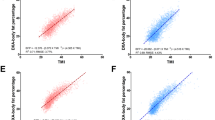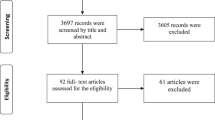Abstract
BACKGROUND:
To assess the relative metabolic load or risk imposed by fatness, fat mass (FM) is commonly expressed as a proportion of weight (% fat), while central adiposity is assessed using the ratio of triceps (TRI) to subscapular (SUBS) skinfolds. The statistical validity of these indices, defined as independence of the index from its denominator, has received inadequate evaluation.
OBJECTIVE:
To critically examine commonly used obesity indices, and to propose more appropriate approaches.
DESIGN:
Cross-sectional studies.
SUBJECTS:
In total, 148 infants; 2195 adult men aged 18 y.
METHODS:
log–log regression analysis was used to explore the relationships between FM and weight (WT) or fat-free mass (FFM) (adults), and between TRI and SUBS (infants and adults).
RESULTS:
The simple indices FM/WT, FM/FFM, TRI/SUBS and SUBS/TRI remained related to their denominators, showing their rankings of individuals to be biased by size or fatness. The appropriate power (p) by which to raise the denominator was determined from regression analyses, and differed from unity in all cases. Both skinfold ratios showed a nonlinear relationship with their denominators.
CONCLUSION:
Simple indices for evaluating whole-body or central adiposity are statistically flawed, and remain influenced by size or fatness of the subject. The index FM/WT is conceptually flawed because FM appears in both numerator and denominator, and the index FM/FFMp is preferable. Skinfold ratios are also problematic, and to evaluate central adiposity SUBS alone, or SUBS/FFMp, may represent more appropriate approaches. These issues should be investigated in other studies in order to address possible influences of age, ethnicity, gender and nutritional status.
This is a preview of subscription content, access via your institution
Access options
Subscribe to this journal
Receive 12 print issues and online access
$259.00 per year
only $21.58 per issue
Buy this article
- Purchase on Springer Link
- Instant access to full article PDF
Prices may be subject to local taxes which are calculated during checkout







Similar content being viewed by others
References
Garrow JS, Webster J . Quetelet's index (W/H2) as a measure of fatness. Int J Obes Relat Metab Disord 1985; 9: 147–153.
Cole TJ, Bellizzi MC, Flegal KM, Dietz WH . Establishing a standard definition for child overweight and obesity worldwide: international survey. BMJ 2000; 320: 1240–1243.
Cole TJ . Weight/heightp compared to weight/height2 for assessing adiposity in childhood: influence of age and bone age on p during puberty. Ann Hum Biol 1986; 13: 433–451.
Gasser T, Ziegler P, Seifert B, Prader A, Molinari L, Largo R . Measures of body mass and of obesity from infancy to adulthood and their appropriate transformation. Ann Hum Biol 1994; 21: 111–125.
Gasteyger C, Tremblay A . Metabolic impact of body fat distribution. J Endocrinol Invest 2002; 25: 876–883.
Lamarche B . Abdominal obesity and its metabolic complications: implications for the risk of ischaemic heart disease. Coronary Artery Dis 1998; 9: 473–481.
Wells JCK . A Hattori chart analysis of body mass index in infants and children. Int J Obes Relat Metab Disord 2000; 24: 325–329.
Wilson BD, Wilson NC, Russell DG . Obesity and body fat distribution in the New Zealand population. N Z Med J 2001; 114: 127–130.
Bose K . Age trends in adiposity and central body fat distribution among adult white men resident in Peterborough, East Anglia, England. Coll Antropol 2002; 26: 179–186.
Katz JR, Taylor NF, Goodrick S, Perry L, Yudkin JS, Coppack SW . Central obesity, depression and the hypothalamo-pituitary-adrenal axis in men and postmenopausal women. Int J Obes Relat Metab Disord 2000; 24: 246–251.
van Lenthe FJ, van Mechelen W, Kemper HC, Twisk JW . Association of a central pattern of body fat with blood pressure and lipoproteins from adolescence into adulthood. The Amsterdam Growth and Health Study. Am J Epidemiol 1998; 147: 686–693.
Schaefer O . Are Eskimos more or less obese than other Canadians? A comparison of skinfold thickness and ponderal index in Canadian Eskimos. Am J Clin Nutr 1977; 30: 1623–1628.
Van Itallie TB, Yang M, Heymsfield SB, Funk RC, Boileau RA . Height-normalised indices of the body's fat-free and fat mass: potentially useful indicators of nutritional status. Am J Clin Nutr 1990; 52: 953–959.
Wells JCK, Cole TJ, ALSPAC study team. Adjustment of fat-free mass and fat mass for height in children aged 8 y. Int J Obes Relat Metab Disord 2002; 26: 947–952.
Wells JCK, Coward WA, Cole TJ, Davies PSW . The contribution of fat and fat-free tissue to body mass index in contemporary children and the reference child. Int J Obes Relat Metab Disord 2002; 26: 1323–1328.
Wells JCK, Ritz P, Davies PSW, Coward WA . Factors affecting the 2H to 18O dilution space ratio in adults. Pediatr Res 1998; 43: 467–471.
Victora CG, Barros FC, Lima RC, Horta BL, Wells J . Anthropometry and body composition of 18 year old men according to duration of breast feeding: a birth cohort study from Brazil. BMJ 2003; 327: 901–905.
Wells JCK, Gigante D, Wright A, Hallal PC, Victora CG . Validation of leg-to-leg impedance for body composition assessment in male Brazilians aged 16–19 years. Int J Body Composition Res 2003; 1: 63–67.
Cole TJ . A chart to link child centiles of body mass index, weight and height. Eur J ClinNutr 2002; 56: 1194–1199.
Barker M, Robinson S, Osmond C, Barker DJ . Birth weight and body fat distribution in adolescent girls. Arch Dis Child 1997; 77: 381–383.
Malina RM, Katzmarzyk PT, Beuen G . Birth weight and its relationship to size attained and relative fat distribution at 7 to 12 years of age. Obes Res 1996; 4: 385–390.
Okosun IS, Liao Y, Rotimi CN, Dever GE, Cooper RS . Impact of birth weight on ethnic variations in subcutaneous and central adiposity in American children aged 5–11 years. Int J Obes Relat Metab Disord 2000; 24: 479–484.
Tien PC, Cole SR, Williams CM, Li R, Justman JE, Cohen MH, Young M, Rubin N, Augenbraun M, Grunfeld C . Incidence of lipoatrophy and lipohypertrophy in the women's interagency HIV study. J Acquir Immune Defic Syndr 2003; 34: 461–466.
Jaquet D, Levine M, Ortega-Rodriguez E, Faye A, Polak M, Vilmer E, Levy-Marchal C . Clinical and metabolic presentation of the lipodystrophic syndrome in HIV-infected children. AIDS. 2000; 14: 2123–2128 AIDS 2000; 14: 2123–2128.
Valdez R, Seidell JC, Ahn YI, Weiss KM . A new index of abdominal adiposity as an indicator of risk for cardiovascular disease. A cross-population study. Int J Obes Relat Metab Disord 1993; 17: 77–82.
Author information
Authors and Affiliations
Corresponding author
Rights and permissions
About this article
Cite this article
Wells, J., Victora, C. Indices of whole-body and central adiposity for evaluating the metabolic load of obesity. Int J Obes 29, 483–489 (2005). https://doi.org/10.1038/sj.ijo.0802899
Received:
Revised:
Accepted:
Published:
Issue Date:
DOI: https://doi.org/10.1038/sj.ijo.0802899
Keywords
This article is cited by
-
Measuring Overnutrition in Children: Do We Know Enough?
Indian Pediatrics (2023)
-
Associations of extracurricular physical activity patterns and body composition components in a multi-ethnic population of UK children (the Size and Lung Function in Children study): a multilevel modelling analysis
BMC Public Health (2019)
-
Estimating body mass and composition from proximal femur dimensions using dual energy x-ray absorptiometry
Archaeological and Anthropological Sciences (2019)
-
Body composition and cardiometabolic health: the need for novel concepts
European Journal of Clinical Nutrition (2018)
-
Body composition at birth and its relationship with neonatal anthropometric ratios: the newborn body composition study of the INTERGROWTH-21st project
Pediatric Research (2017)



